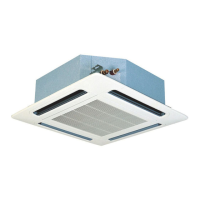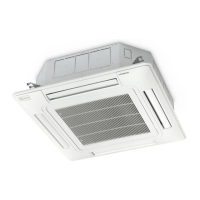! CAUTION
• Do not create an upper-slope or rise for the drain piping, since drain
water will ow back to the unit and leakage to the room will occur
when the unit operation is stopped.
• Do not connect the drain pipe with sanitary or sewage piping or any
other drainage piping.
• When the common drain piping is connected with other indoor units,
the connected position of each indoor unit must be higher than the
common piping. The pipe size of the common drain pipe must be large
enough according to the unit size and number of unit.
• Drain piping will require insulating if the drain is installed in a location
where condensation forming on the outside of drain pipe may drop
and cause damage. The insulation for the drain pipe must be selected
to insure vapor sealing and prevent condensation forming.
• Drain trap should be installed next to indoor unit. This trap must be
designed to good practice and be checked with water (charged)
and tested for correct ow. Do not tie or clamp the drain pipe and
refrigerant pipe together.
? NOTE
Install drainage in accordance with national and local codes.
After performing drain piping work and electrical wiring, check to
ensure that water ows smoothly as in the following procedure:
Checking with drain-up mechanism and oat
switch
• Switch ON the power supply.
• Pour approximately 2.0 to 2.5 liters of water gradually into
the drain pan, then oat switch up and drain pump start
working automatically.
• Check to ensure that the water ows smoothly inside the
transparent drain pipe connection whether no water leakage
occurs. When water cannot be found at the end of the drain
piping, pour more water smoothly into the drain pan.
• If the water overows from the drain pan, recheck the drain
piping.
• Switch OFF the power supply after.
? NOTE
Pay attention to the thickness of the insulation when the left side piping is
performed. If it is too thick, piping can not be installed in the unit.
5.2 DRAIN PIPE CONNECTION
1 The position of the drain pipe connection is shown below.
55
82
184
(mm)
2 Prepare a polyvinyl chloride pipe with a 32mm outer
diameter.
3 Fasten the tubing to the drain hose with an adhesive and the
factory-supplied clamp.
28mm
20
+
5mm
Hose band (accessory)
Use vinyl chloride
type adhesive
Tightening torque:
3.0 - 3.5N.m
Elbow or vinyl chloride VP25
(Field-supplied)
Vinyl tape
Drain pipe connection
for checking drainage
(transparent)
Drain hose
(accessory)
Max. 300mm
4 The drain piping must be performed with a down-slope pitch
of 1/25 to 1/100.
5 a+b+c ≤ 1100mm
b
c ≤ 50mm
Ceiling
Hose band
(accessory)
a (Max. 300mm)
Drain hose (accessory)
Support
part
1 to 1.5m
1/25 to 1/100
Down-slope
Max. 850mm
6 Do not apply excessive force to the Drain Pipe connection. It
could cause a damage.
7 Do not use a bent or twisted Drain Hose. It will cause water
leakage.
8 Insulate the drain pipe after connecting the drain hose.
Hose band (accessory)
Insulation (5T x 270 x 270) (accessory)
Wrap up the drain hose completely to
cover the hose band
? NOTE
If there is excessive clearance between the drain pipe connection and the
drain hose, add a sealing material between both parts in order to t and
not deform the drain hose.
DRAIN PIPING
PMML0547 rev.0 - 11/2020
8

